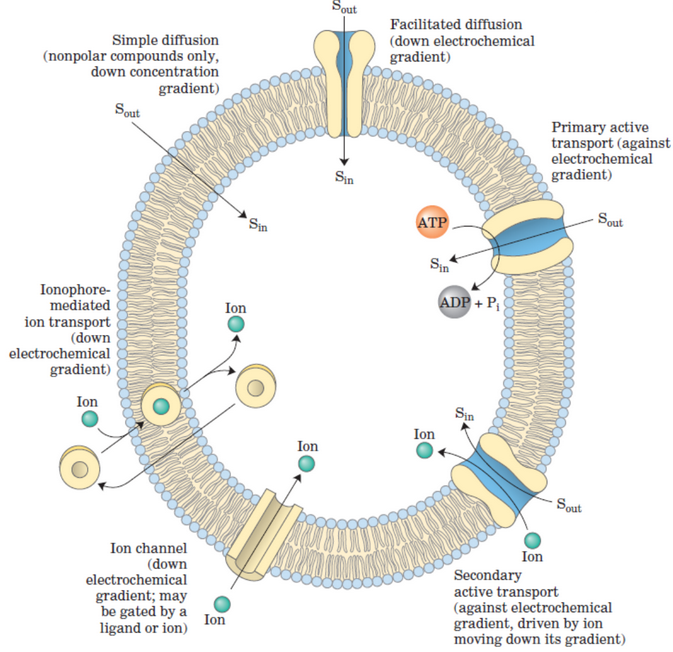11.3 Passive and Active Transport
Figure 11.12: Modes of Membrane Transport
In a cell, molecules can be transported across the cell membrane via the action of:
Small molecules
These act as ion carriers.
Larger proteins
These are highly specific transporters.
Proteins that promote the formation of membrane vesicles
As seen in figue 11.13, molecule transport across a cell membrane can either be passive or active.
Figure 11.13: Active and Passive Membrane Transport
Passive transport refers to substances diffusing down their concentration gradients (and hence, into the cell).
Active transport is the usage of energy (e.g., ATP) to transport substances against their concentration gradients.
11.3.1 Passive transport
Small, nonpolar molecules and lipid-soluble substance (including steroids) are able to diffuse through the hydrophobic lipid bilayer in this manner.
In facilitated diffusion, the molecule binds to a membrane protein that changes shape to release the transported molecule on the other side of the membrane.
11.3.1.1 Channel proteins
Figure 11.14: Channel and Carrier Proteins
Channel proteins (see figure 11.14) have a hydrophilic channel that provides an aqueous channel for polar molecules to pass through (when the channel is open).
During simple diffusion, the removal of a hydration shell is very endergonic; the activation energy (i.e., the \(\Delta G\)) for diffusion through the bilayer is also very high. Transporter proteins reduce the \(\Delta G\) for the transmembrane diffusion of substances by forming noncovalent interactions with the solute (thereby creating a hydrophilic transmembrane passageway).
11.3.1.2 Carrier proteins
Carrier proteins (see figure 11.14) specifically bind to the molecule that they assist (much like an enzyme).
These channel and carrier proteins are usually selective for one type of molecule - this creates a selective permeable membrane.
11.3.1.3 Osmosis
Figure 11.15: An Osmosis Experiment
Osmosis (see figure 11.15) is the passive movement of water across membranes. Water diffuses towards the side of the membrane with a higher solute concentration; the osmotic concentration of the solution is the concentration of all solutes in the solution.
Figure 11.16: Cells Under Different Solution Tonicities
Figure 11.16 represents three different tonicities of solutions.
A hypertonic solution is a solution that has a higher concentration of solutes than another solution. When a solution is hypertonic, water moves out of the cell (causing the cell to shrivel), hence maintaining osmotic pressure. Strangely enough, most plant cells are hypertonic!
A hypotonic solution means the inverse of a hypertonic solution. Here, water moves into the cell, hence applying to the plasma membrane until the cell ruptures. The resulting internal hydrostatic pressure is called the **turgor pressure*.
In an isotonic solution, two solutions share the same osmotic concentrations. Hence, water diffuses into and out of the cell at the same rate.
11.3.1.3.1 Aquaporins
In living cells, the flow of water into and out of the cell is facilitated by membrane proteins called aquaporins.
While more than 11 types of aquaporins have been identified, most fall into two general classes:
- Water-specific aquaporins
- Those that allow small, hydrophilic molecules (e.g., glycerol and urea) to cross the membrane.
11.3.2 Active transport
Active transport generally requires ATP - the usage of which can be direct or indirect.
Active transport is also performed by highly selective protein carriers that are embedded in the cell membranes. A uniporter is a protein carrier that is capable of transporting a single molecule.
Figure 11.17: Mechanism of the Sodium / Potassium Pump
When a protein carrier transports two molecules, a symporter (i.e., “same direction”) or an antiporter (i.e., “different directions”) is present.
Protein carriers allow cells to maintain a concentration gradient that is different from their surroundings (e.g., the Na+ / K+ pump).
11.3.2.1 Coupled transport
Figure 11.18: Coupled Transport
This form of active transport utilizes ATP indirectly.
In the example in figure 11.18, a membrane protein transports Na+ into the cell (and down its concentration gradient) and transporting glucose into the cell at the same time.
This concentration gradient driving the influx of Na+ ions also allows glucose molecules to be transported against their concentrations. This Na+ gradient is maintained by the Na+ / K^+ gradient in 11.17.
11.3.2.2 Summary of membrane transport proteins

Figure 11.19: Summary of Active and Passive Transport Components
Figure 11.19 displays a concise summary of the material in the previous subsections.
Also note that an ionophore is a small molecule that masks the charge of ions, hence allowing them to diffuse through the lipid bilayer.